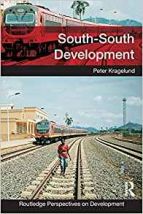South-South Development

South-South Development investigates the current resurgence of South-South collaboration (SSC), unleashed after the Forum on Chinese Africa Cooperation (FOCAC) summit in 2006. The book aims to disaggregate the different vectors of engagement and the various actors involved in driving the current wave of SSC development. It focuses particularly on aid, trade, investments, education, migration and governance (Chapter 4). Beyond this, the book interrogates the implications of the resurgence of SSC on other actors in the global North (Chapter 6), and its economic, social and political effects on the rest of the global South (Chapter 7).
South-South Development draws on a variety of primary and secondary sources of information on SSC from all over the global South, while remaining critical of their accuracy and objectivity. The book is aimed towards a student audience, with each chapter ending with a brief summary, discussion questions and suggestions for further reading.
The book begins by exploring the concept of the “global South” as “the most recent concept describing materially less rich parts of the world” (page 4). Although the concept has limitations, its main strength lies in the way it illuminates the existence of inequalities and exploitation all over the world. Additionally, the category “global South” is neither homogenous nor static; countries within this category differ in terms of their levels of development and economic and political power, and these fluctuate over time. These variations between Southern countries hint at their potential roles in terms of trade, investments and global governance, with the BRICS countries driving South-South investment, aid and trade flows.
Author Peter Kragelund argues that the current wave of SSC is not ahistorical, and instead refers back to the previous era of SSC in the 1960s and 1970s – albeit with vastly different political and economic contexts. To this end, Chapter 2 historicizes SSC by considering its development from the end of World War II until its temporary collapse due to several related incidents, including the Cold War, the oil crisis and the debt crisis in the 1980s.
However, the current SSC differs from the previous era in terms of the main actors involved and their underlying motivations. Most of the current SSC actors have little interest in radically changing the overall system governing world affairs. Instead, many of them “benefit from – and further promote – the current neoliberal world order” (page 157). Ultimately, South-South Development presents an analytical framework for understanding how SSC has affected the global South. This framework stresses the importance of looking beyond direct and intended effects of SSC to consider the indirect and/or unintended impacts of the collaboration. To this end, it highlights the importance of disaggregating all the vectors of engagement and examining how they interrelate.
Book note prepared by Kate Goh
Search the Book notes database
Our Book notes database contains details and summaries of all the publications included in Book notes since 1993 - with details on how to obtain/download.
Use the search form above, or visit the Book notes landing page for more options and latest content.
For a searchable database for papers in Environment and Urbanization, go to http://eau.sagepub.com/

